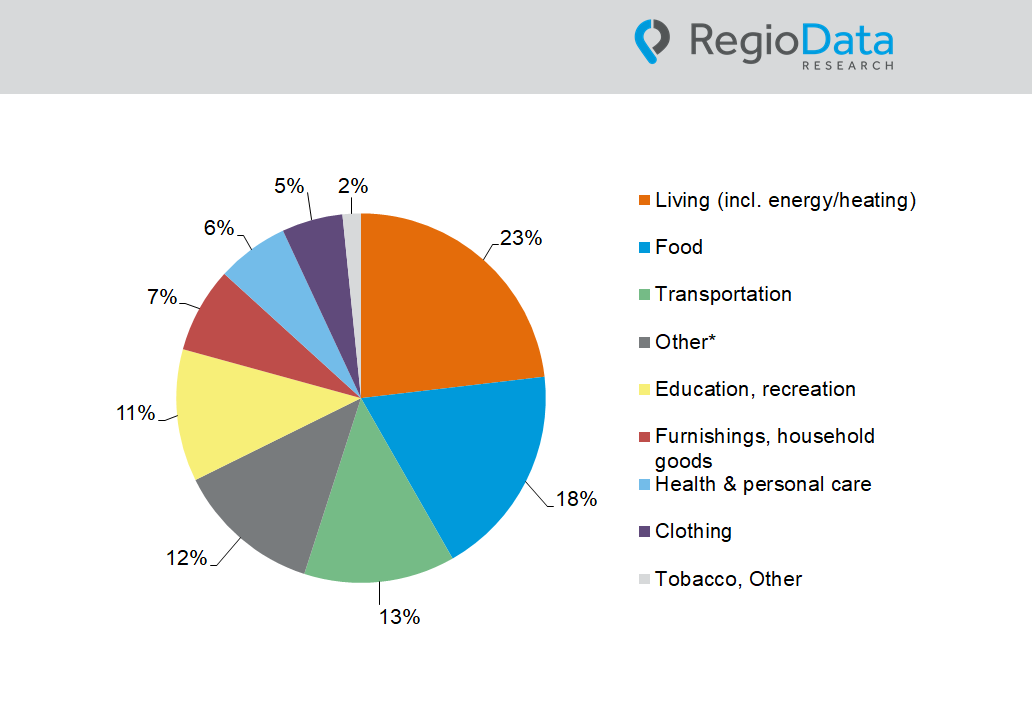Austria
Consumer Spendings and Value Change: More Fun – Less Shopping
The long-term comparison of Austrians’ spending patterns reveals significant shifts: a smaller proportion is spent on “things,” while more is spent on fun, entertainment, dining out, and self-improvement.
New distribution of funds
The change in general consumption attitudes is also reflected in the long-term comparison of spending categories from 2014 to 2024. Currently, each resident has an average of €27,075 available per year, compared to €19,970 ten years ago. Due to the overall inflation of 33% during this period, the real increase in purchasing power is only 3%. Thus, available purchasing power has risen only marginally on average, while the allocation of funds has changed significantly.
Of the average annual consumer spending of approximately €27,100 per Austrian, around €23,300 is spent on private consumption purposes. The remaining nearly €3,700 used for non-private expenses is largely allocated to savings deposits, which amount to about €2,400 per person. Compared to the previous year, these savings deposits have increased significantly, with a substantial part of the rise attributed to higher interest rates on savings.
Housing and transportation at the top of expenditures
In absolute terms, both ten years ago and today, the largest share of money by far is spent on housing (excluding heating costs), with an average of €4,666 per resident per year. This represents a 46% increase compared to 2014, while inflation during the same period has risen by only 33%.
The second-largest spending category is transportation, which includes the purchase and operation of personal vehicles, public transportation, as well as data traffic and communication. Annual expenditures per resident in this category amount to approximately €3,315. In the long-term comparison, this category has increased only slightly above the rate of inflation.
In third place are expenditures for food (excluding dining out), for which €3,144 is spent per resident annually. This figure has risen in line with inflation over the past few years.
Significantly less is spent on energy (household), amounting to €1,396. However, this category has nearly doubled in the last ten years, growing almost twice as fast as inflation.
More money for fun and self-care, less for fashion, tech, and home furnishings
To explore the changes in consumer behavior, it’s worth looking at the details, and one thing becomes clear: Everything related to fun, relaxation, and self-improvement is rising disproportionately, while once-dominant retail products like clothing, shoes, electronics, and home furnishings are becoming less important. Even the cultural sector, including books, which used to be a staple of consumer behavior, is slipping further down the priority list for Austrians.
Over the past ten years, consumer spending in certain areas has drastically changed. Particularly striking is the sharp increase in in-game purchases—digital transactions within video games—which have surged by an impressive 771% since 2014 and now stand at around €61 per resident per year. This amount is roughly equivalent to the total expenditure on books. The bicycle market has also boomed, with a remarkable 415% increase, primarily driven by the significantly more expensive e-bikes.
Another significant trend is the rise in spending on pets, which has increased by 170%. This growth was also fueled by the so-called “pandemic dogs,” leading to a nearly 10% increase in the number of dogs during the pandemic, resulting in higher veterinary costs and increased spending on pet food.
Spending on dining out continues to reach record levels
Expenditures on dining out have continued their upward trend, consistently growing beyond increases in purchasing power for the past decade—except for the pandemic-related declines from 2020 to 2022. Currently, the average annual spending on dining out per Austrian is €1,842, representing a 13% increase from the previous year alone.
The majority of these expenditures, around €1,515, are spent on leisure dining experiences such as visits to restaurants and cafés, while the remaining amount is allocated to meals in workplace and school cafeterias. For comparison, in 2014, spending on leisure dining was €973 per person.
From “pandemic outliers” to new consumer norms
The COVID-19 pandemic has played a significant role in changing consumer habits, leading to noticeable outliers in many consumption categories that are now solidifying into lasting trends. In addition to the sharply increased spending on dining out, vacations, and pets, investments in personal improvement have also become particularly prominent. The rapidly growing categories range from nutrition (organic, vegan, supplements) to more invasive expenditures. Cosmetic procedures, including non-surgical treatments, have seen a significant surge, now averaging €68 per person per year—a 172% increase since 2014. Similarly, spending on tattoos has risen at an equally strong rate.
share post



